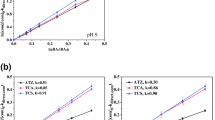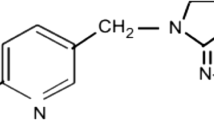Abstract
UV/H2O2/micro-aeration is a newly developed process based on UV/H2O2. Halogenated pesticide 2,4-dichlorophenoxyacetic acid (2,4-D) photochemical degradation in aqueous solution was studied under various solution conditions. The UV intensity, initial 2,4-D concentrations and solution temperature varied from 183.6 to 1048.7 μW·cm−2, from 59.2 to 300.0 μg·L−1 and from 15 to 30°C, respectively. The concentration of hydrogen peroxide (H2O2) and pH ranged from 0 to 50 mg·L−1 and 5 to 9, and different water quality solutions (tap water, distilled water and deionized water) were examined in this study. With initial concentration of about 100 μg·L−1, more than 95.6% of 2,4-D can be removed in 90 min at intensity of UV radiation of 843.9 μW·cm−2, H2O2 dosage of 20 mg·L−1, pH 7 and room temperature. The removal efficiency of 2,4-D by UV/H2O2/micro-aeration process is better than UV/H2O2 process. The photodecomposition of 2,4-D in aqueous solution follows pseudo-first-order kinetics. 2,4-D is greatly affected by UV irradation intensity, H2O2 dosage, initial 2,4-D concentration and water quality solutions, but it appears to be slightly influenced by pH and temperature. There is a linear relationship between rate constant k and UV intensity and initial H2O2 concentration, which indicates that higher removal capacity can be achieved by the improvement of these factors. Finally, a preliminary cost analysis reveals that UV/H2O2/micro-aeration process is more cost-effective than the UV/H2O2 process in the removal of 2,4-D from drinking water.
Similar content being viewed by others
References
Chu W. Modeling the quantum yields of herbicide 2,4-D decay in UV/H2O2 process. Chemosphere, 2001, 44: 935–941
Bandalaa E R, Peláeza M A, Dionysiou D D, Gelover S, Garcia J, Macias D. Degradation of 2,4-dichlorophenoxyacetic acid (2,4-D) using cobalt-peroxymonosulfate in Fenton-like process. J Photochem Photo boil A: Chem, 2007, 186: 357–363
Colborn T, VomSaal F S, Soto A M. Developmental effects of endocrine disrupting chemicals in wildlife and humans. Environ Health Perspet, 1993, 101(5): 378–381
Chu W, Kwan C Y, Chan K H. An unconventional approach to studying the reaction kinetics of the Fenton’s oxidation of 2,4-dichlorophenoxyacetic acid. Chemosphere, 2004, 57: 1165–1171
Gouin T, Wania F, Ruepert C, Castillo L E. Field testing passive air samplers for current use pesticides in a tropical environment. Environ Sci Technol, 2008, 17: 6625–6630
World Health Organization (WHO). Guidelines for drinking-water quality. In: Health Criteria and Other Supporting Information. Addendum to vol 2, 2nd ed. World Health Organization, Geneva, 1998. 191–199
US Environmental Protection Agency (USEPA). Registration Eligibility Decision for 2,4-D. 2005
Li Y J, Li J, Ma M Y, Ouyang Y Z, Yan W B. Preparation and photocatalytic activity of TiO2-coated granular activated carbon composites by a molecular adsorption-deposition method. Sci China Ser B-Chem, 2008, 51(11): 1036–1043
Gao N Y, Deng Y, Zhao D D. Ametryn degradation in the ultraviolet (UV) irradiation/hydrogen peroxide (H2O2) treatment. J Hazar Mater, 2009, 164: 640–645
Washida N, Mori Y, Tanaka I. Quantum yield of ozone formation from photolysis of the oxygen molecule at 1849 and 1931Å. J Chem Phys, 1971, 3: 1119–1122
Hajime S, Yoshimitsu T, Shigeru T. Photodegradation of chlorinated hydrocarbons in the presence and absence of dissolved oxygen in water. Water Res, 2001, 8: 1941–1950
Kamps R, Müller H, Schmitt M, Sommer S, Wang Z, Kleinermanns K. Photooxidation of exhaust pollutants. 1. Degradation efficiencies, quantum yields and products of benzene photooxidation. Chemosphere, 1993, 11: 2127–2142
Legrini O, Oliveros E, Braun M A. Photochemical processes for waste treatment. Chem Rev, 1993, 93: 671–698
Green J R, Margerison D. Statistical Treatment of Experimental Data. New York: Elsevier, 1977. 198–293
Nienow A M, Bezares-Cruz J C, Poyer I C, Hua I, Jafvert C T. Hydrogen peroxide-assisted UV photodegradation of Lindane. Chemosphere, 2008, 72: 1700–1705
Byung S O, Kyoung S K, Min G. K. Kinetic study and optimum control of the ozone/UV process measuring hydrogen peroxide formed in-situ. Ozone Sci Eng, 2005, 6: 421–430
Fox M A, Dulay M T. Heterogeneous photocatalysis, Chem. Rev 1993, 93: 341–357
Buxton G V, Greenstock C L, Helman W P, Ross A B. Critical review of rate constants for reactions of hydrated electrons, hydrogen atoms and hydroxyl radicals (·OH/·O−) in aqueous solution. J Phys Chem Ref Data, 1988, 17: 513–886
Prices & People. Chem Mark Rep, May 26, 2003, 20–22
Englehardt J, Deng J, Polar J, Meeroff D, Legrenzi Y, Mognol J. Options for managing municipal landfill leachate: Year 1 development of iron-mediated treatment processes. Project Report #0432024-06. Hinkley Center for Solid and Hazardous Waste Management, 2006
Author information
Authors and Affiliations
Additional information
Supported by the National Major Science and Technology Project (Grant No. 2008ZX07421-002) and "11th Five-year Plan" Science and Technology Support Projects (Grant No. 2006BAJ08B06) and 973 program (Grant No. 2006CB403204)
Rights and permissions
About this article
Cite this article
Chu, W., Gao, N., Li, C. et al. Photochemical degradation of typical halogenated herbicide 2,4-D in drinking water with UV/H2O2/micro-aeration. Sci. China Ser. B-Chem. 52, 2351–2357 (2009). https://doi.org/10.1007/s11426-009-0132-x
Received:
Accepted:
Published:
Issue Date:
DOI: https://doi.org/10.1007/s11426-009-0132-x




